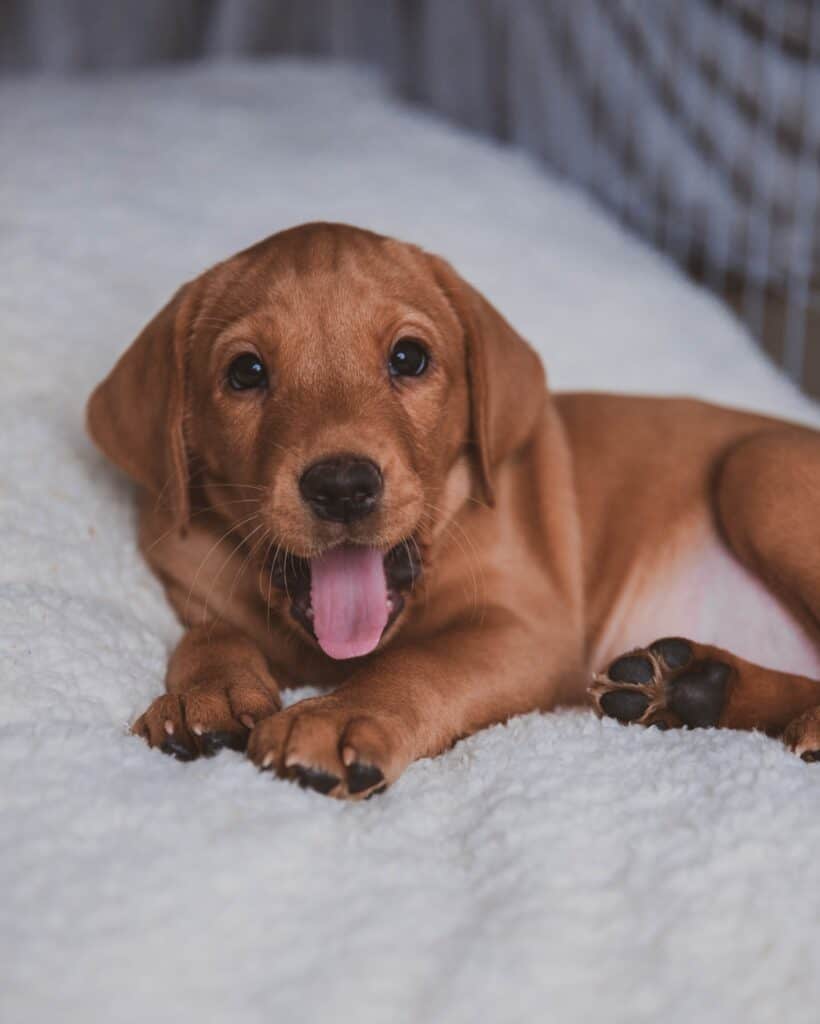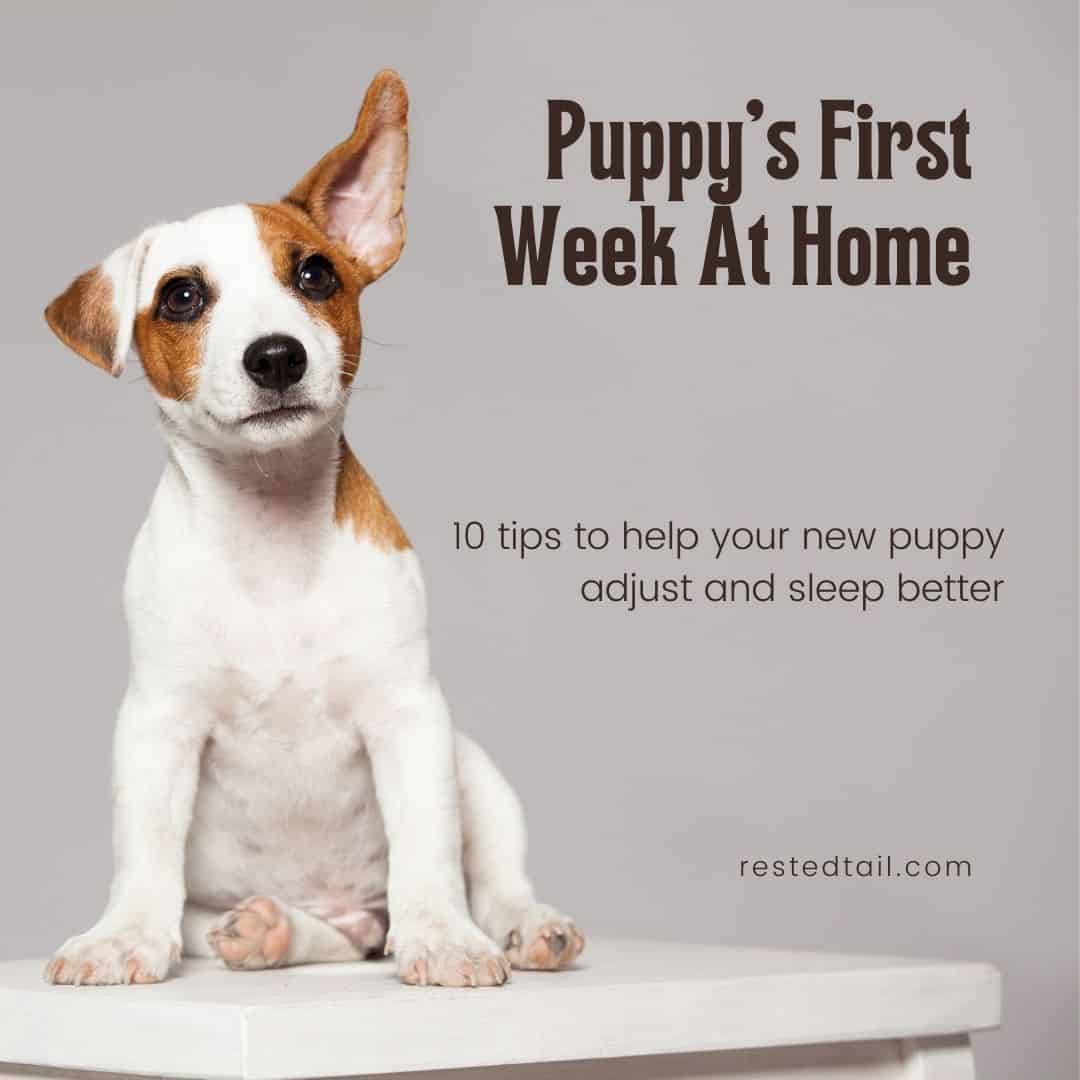You just brought your new puppy home! Congratulations on your new little addition to the family. Your puppy first week at home can be a lot of work, and it’s essential to take care of them properly for them to become a well-adjusted family member.
Rested Tail is a company that helps dog owners by providing them with a place to find all the things they need for their furry friend, from beds, toys, training, and everything in between.
Our blog posts’ goal is to help you understand how you can make your puppy’s first week at home as smooth as possible so he can adjust quickly and sleep better. We hope this post will offer some insight on what to do during the first week of bringing him home.
Designated Area
Introduce your puppy to the house slowly and make sure they have enough space for them to run around in the house or apartment off-leash.
Puppies like to explore, and they need room to do so.
But you don’t want your pup to run all over the house and get into things. It’s too much information overload for her early on.
So, make sure you have a designated area for them to explore and play in the house or apartment off-leash with their toys!
This designated area will help your pup feel more comfortable exploring around inside of his new home while still keeping him safe from getting hurt.
It also helps keep other items like shoes out of reach too 😉
And don’t forget that puppies need plenty o’ sleep, so be mindful when they are tired–They’ll let you know by yawning/crying if it’s time for some shut-eye 🙂
For more information on puppies sleep habits, check out this detailed blog by the American Kennel Club.

Safe And Secure
Create an area for the dog in your home where they feel safe and secure.
Whether it is a crate or designated space like an x-pen that’s just theirs, with their bedding/dog blanket in it, so you know when to put them back there at night time!
You can also use dog gates if needed as well – this will help keep him out of trouble while still giving him some room (and peace) from other pets who might want his toys too 😉
Dog gates are a great accessory to have for your new pup! You can use that as an effective way of keeping him out of any designated area you have in the house.
Check out my blog on the different types of dog gates and which ones are best for your home.
Slow Introduction
Don’t overwhelm them with too many people or dogs right away – introduce them slowly by letting friends come over one at a time.
If you have other pets, introduce them slowly as well!
Make sure to supervise all interactions between your new pup and the others for everyone’s safety. Make a plan with friends or family members who will be around, so they know what is expected of their dog when meeting yours.
Also make sure to keep dogs on leash.
Socialization with other dogs is important for your dog’s development.
Food And Water Bowl
Have a water bowl and a food bowl ready for them – it’s essential to have a designated place where they can eat and drink.
Suppose you’re not sure what type of food your pup needs, consult with the vet! They’ll give you ideas from their age/size and how much is appropriate per day.
If possible, try feeding high-quality dog foods containing higher protein levels, which helps keep dogs healthy.
You should feed them twice daily at regular intervals, making time every morning before work if necessary, and another meal at night should be sufficient.
But don’t overfeed. Overfeeding could lead to some health issues; bloating, diarrhea, and vomiting due to gas in the stomach.
Also, provide plenty of water: Dogs need fresh, clean drinking water available all day long; Water is essential for proper hydration and digestion.
Dog Crate
Crate training your puppy first week at home will help them feel more secure and comfortable in their new home. It’s also a good idea to have one when you’re not at home so they can’t get into things or make messes while left alone (chewing on furniture, tearing up your shoes).
Crate training your puppy early on will help you tremendously in the long run.
The crate should be big enough for your puppy to stand up, turn around and lie down comfortably in it without feeling cramped or anxious.
It will also help your pup feel more secure.
Basic Commands
Teach him some basic commands like sit and stay.
The more you teach your pup, the more you’ll be able to control him.
The best way for your pup is not only with treats but also by using a clicker or other sound-marking device to help them understand what they’re doing right and wrong when it comes time to do something like sit down on command in front of their food bowl before eating.
Teaching him commands can also help with his anxiety and fear of new environments or people in general (especially if it’s a rescue dog). It may take some time for them to adjust, but as long as there is consistency on their part-and yours–they’ll eventually learn what’ll make life easier around here:). One of the best online dog training resources is Brain Training for Dogs.
They have a ton of videos on how to train your pup, as well as tips and tricks for teaching them commands like sit or stay! I highly recommend checking this training course out :). It helped me so much with the training of my dog that I feel confident recommending their services. It’ll help make life easier for you and your pup :).
Don’t forget about those basic obedience skills when teaching our furry friends some manners ;)! It will pay off tenfold down the road!! And who doesn’t want an obedient puppy? Not only are they more likely not to get themselves hurt by doing what you ask, but they’ll also be more likely to listen and obey you when it comes time for them to go out in public.
Brain training for dogs is a fantastic online dog training course.
You can check out the detailed review here or go straight to the dog training website.
Best Dog Bed For Puppy
Make sure your puppy has a comfortable bed.
Trying to help your puppy first week at home to sleep better at night?
One of the most important things you can do is teach your puppy to sleep in her bed. A dog bed helps with separation anxiety. She’ll be used to sleeping on her “own” and not yours!
It also helps them get more comfortable being alone at night when everyone’s asleep or away from home for a few hours during workdays.
You want this habit started early, so it becomes second nature by adulthood; otherwise, she may never adjust properly because getting accustomed takes time – don’t wait until after four months have passed before starting training!
A good bed will be comfortable, and it should also have a soft surface.
Pets who sleep on hard surfaces can suffer hip dysplasia, arthritis, and luxating patella.
Fortunately, an orthopedic bed is easy to find and should change your dog’s sleeping patterns for the better.
So make sure you get them something nice that feels like home right away.
A few great options are Memory foam beds (my personal favorite), cuddly dog blankets/bedding made of fleece material; any type is acceptable as well- avoid anything rough such as outdoor carpeting if possible) , old towels folded up into squares work just as well because puppies love snuggling.
Try placing the dog’s bed in a room where they feel safe and secure. Your dog will be able to sleep better, which results in less anxiety for both of you.
Check out our full library of dog bed reviews here.
Daily Walks
Take your new puppy out for walks every day.
Walks will help him learn to go potty outside, and it also gives you a chance for some bonding time.
It’s vital for your puppy first week at home that he gets used to the sights, sounds, and smells of his new home.
So take your pup on walks around town or in nearby parks every day! It is beneficial if there are any other pets at home since they can get territorial about their space; this way, everyone has an opportunity to explore without feeling threatened by another animal (or vice versa).
If possible, try taking them out at different times throughout the day.
The best tip I heard from my vet is to take your pup out for a walk before bedtime. Doing that will help him learn that going potty outside is the best thing he can do right now, and it also helps him sleep better throughout the night!
Provide Chew Toys
Puppies like to chew on things. It’s essential to provide them with appropriate chew toys to keep them from chewing on furniture or other off-limits items.
The best time for a puppy is during the day when you’re home so that they can get plenty of attention! Also, it would be best if you kept an eye on your puppy when they’re playing with other dogs.
You will need a variety of chew toys so that your puppy will find the one toy in their collection which is just right to satisfy his chewing needs and keep them occupied!
You’ll want different types: hard rubber ones are good because pups like chewing on those; softer fabric-type chews too.
Some puzzle dog toys will engage your dog’s brain and keep them occupied for hours.
In his book “Complete Guide to Pet Health,” DVM, MPH, CAWA Gary Weitzman says, “The best toys replicate natural behavior. Enrichment toys are important for mental and physical development. Interactive toys, such as those with food or treats inside them to encourage your dog’s natural hunting instincts.”
Many manufacturers also list recommendations based on how big your dog is, its weight, and chewing capacity.
Best Tip To Help Your Puppy First Week At Home
I hope with these tips and tricks, your pup’s adjustment phase is much more manageable. Your new friend might be a little grumpy or in an unsure mood when you first bring him home but remember, not everything happens immediately! It can take up to three weeks for a new pet to adjust well enough to be comfortable with its new environment and owner.
So in the meantime, the best tip I can give you to help your puppy first week at home to adjust and sleep better is to provide him with lots of love and attention to help with the adjustment process. Dogs crave socialization and affection from humans; it makes them feel loved and wanted, which will give them confidence.
And don’t forget to check out the dog training program. It will make the adjustment period go so much smoother.
Featured Photo by Picsea on Unsplash
Recent Posts
As a dog owner, you want to ensure that you take proper care of your furry companion. A common question that many pet owners have is, "Can I walk my dog 30 minutes after eating?" Understanding the...
Have you ever considered getting an elevated dog bed for your furry friend, but wondered if it's worth the investment? If so, you're not alone. As dog owners, we all want to provide the best care for...

